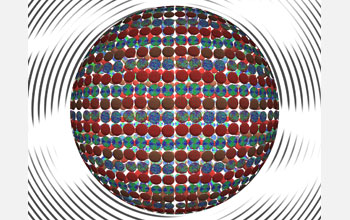Home > Press > Liquid Crystal Design: Engineers develop technique to craft new materials using liquid crystals as structural guides
 |
| In this creative illustration, each small disc depicts actual data from computational models of nanometer-scale droplets containing liquid crystals, water and surfactants (molecules that lower the surface tensions of liquids). The different patterns show how the surfactants self-organize as they interact with liquid crystals on each droplet's surface.
Credit: Juan de Pablo, University of Wisconsin - Madison |
Abstract:
Liquid crystals, ubiquitous in cell-phone screens and computer monitors, were known to science long before engineers realized their utility in displays and other technologies. Now, an international team of researchers has discovered how to use liquid crystals as scaffolding to build novel materials with undiscovered properties.
Liquid Crystal Design: Engineers develop technique to craft new materials using liquid crystals as structural guides
Arlington, VA | Posted on May 3rd, 2012Reporting their findings in the journal Nature on May 3, the researchers describe a sophisticated computational model for determining how liquid crystals behave within the confines of nanometer-scale droplets containing molecules that lower the surface tensions of liquids, called surfactants.
The researchers, led by University of Wisconsin-Madison engineer Juan de Pablo, show that as the droplets cool, the liquid crystals confine the surfactant molecules, organizing them into discrete structures.
As the researchers adjusted the model's parameters, such as droplet size or surfactant concentration, the simulation revealed that it is possible to use the technique to guide self-assembled structures with a wide range of properties and applications.
For example, the researchers suggest the technique could be used to construct materials from DNA building blocks, allowing unique detectors for biological materials and toxins.
"The researchers have taken a new and exciting approach to the study of liquid crystals, which will have impact in several scientific and technical arenas," adds Mary Galvin, National Science Foundation (NSF) program director for Materials Research Science and Engineering Centers.
NSF supported the research through the University of Wisconsin-Madison's Center on Nanostructured Interfaces, an NSF Center of Excellence for Materials Research and Innovation.
####
About National Science Foundation
The National Science Foundation (NSF) is an independent federal agency that supports fundamental research and education across all fields of science and engineering. In fiscal year (FY) 2012, its budget is $7.0 billion. NSF funds reach all 50 states through grants to nearly 2,000 colleges, universities and other institutions. Each year, NSF receives over 50,000 competitive requests for funding, and makes about 11,000 new funding awards. NSF also awards nearly $420 million in professional and service contracts yearly.
For more information, please click here
Contacts:
Media Contacts
Joshua A. Chamot
NSF
(703) 292-7730
Terry Devitt
Univeristy of Wisconsin - Madison
(608) 262-8282
Program Contacts
Mary E. Galvin
NSF
(703) 292-8562
Principal Investigators
Juan de Pablo
Univeristy of Wisconsin - Madison
(608) 262-7727
Copyright © National Science Foundation
If you have a comment, please Contact us.Issuers of news releases, not 7th Wave, Inc. or Nanotechnology Now, are solely responsible for the accuracy of the content.
| Related News Press |
News and information
![]() Researchers develop molecular qubits that communicate at telecom frequencies October 3rd, 2025
Researchers develop molecular qubits that communicate at telecom frequencies October 3rd, 2025
![]() Next-generation quantum communication October 3rd, 2025
Next-generation quantum communication October 3rd, 2025
![]() "Nanoreactor" cage uses visible light for catalytic and ultra-selective cross-cycloadditions October 3rd, 2025
"Nanoreactor" cage uses visible light for catalytic and ultra-selective cross-cycloadditions October 3rd, 2025
Display technology/LEDs/SS Lighting/OLEDs
![]() Spinel-type sulfide semiconductors to operate the next-generation LEDs and solar cells For solar-cell absorbers and green-LED source October 3rd, 2025
Spinel-type sulfide semiconductors to operate the next-generation LEDs and solar cells For solar-cell absorbers and green-LED source October 3rd, 2025
Govt.-Legislation/Regulation/Funding/Policy
![]() New imaging approach transforms study of bacterial biofilms August 8th, 2025
New imaging approach transforms study of bacterial biofilms August 8th, 2025
![]() Electrifying results shed light on graphene foam as a potential material for lab grown cartilage June 6th, 2025
Electrifying results shed light on graphene foam as a potential material for lab grown cartilage June 6th, 2025
![]() Institute for Nanoscience hosts annual proposal planning meeting May 16th, 2025
Institute for Nanoscience hosts annual proposal planning meeting May 16th, 2025
Discoveries
![]() Researchers develop molecular qubits that communicate at telecom frequencies October 3rd, 2025
Researchers develop molecular qubits that communicate at telecom frequencies October 3rd, 2025
![]() Next-generation quantum communication October 3rd, 2025
Next-generation quantum communication October 3rd, 2025
![]() "Nanoreactor" cage uses visible light for catalytic and ultra-selective cross-cycloadditions October 3rd, 2025
"Nanoreactor" cage uses visible light for catalytic and ultra-selective cross-cycloadditions October 3rd, 2025
Announcements
![]() Rice membrane extracts lithium from brines with greater speed, less waste October 3rd, 2025
Rice membrane extracts lithium from brines with greater speed, less waste October 3rd, 2025
![]() Researchers develop molecular qubits that communicate at telecom frequencies October 3rd, 2025
Researchers develop molecular qubits that communicate at telecom frequencies October 3rd, 2025
![]() Next-generation quantum communication October 3rd, 2025
Next-generation quantum communication October 3rd, 2025
![]() "Nanoreactor" cage uses visible light for catalytic and ultra-selective cross-cycloadditions October 3rd, 2025
"Nanoreactor" cage uses visible light for catalytic and ultra-selective cross-cycloadditions October 3rd, 2025
Research partnerships
![]() Lab to industry: InSe wafer-scale breakthrough for future electronics August 8th, 2025
Lab to industry: InSe wafer-scale breakthrough for future electronics August 8th, 2025
![]() HKU physicists uncover hidden order in the quantum world through deconfined quantum critical points April 25th, 2025
HKU physicists uncover hidden order in the quantum world through deconfined quantum critical points April 25th, 2025
|
|
||
|
|
||
| The latest news from around the world, FREE | ||
|
|
||
|
|
||
| Premium Products | ||
|
|
||
|
Only the news you want to read!
Learn More |
||
|
|
||
|
Full-service, expert consulting
Learn More |
||
|
|
||








